|
 Secure Site
Secure Site
|
 |
Archive for the 'mindfulness practice' Category
 meditating makes you happier A few years back, the notion that meditation could bring bliss was something only a swami might swallow. Today it’s an idea that rings true to the ever-increasing numbers of people—from Madonna and Tiger Woods to thousands of ordinary Janes and Joes—who are making meditation a part of their everyday lives.
For years, studies have suggested that meditating can ease chronic pain, lower blood pressure, and reduce anxiety. But University of Wisconsin researchers recently broke new ground, uncovering physical evidence that it may actually make us happier.
A group of stressed-out employees at a biotech company was taught mindfulness meditation and was asked to meditate at home for an hour a day, six days a week, for eight weeks. The researchers measured electrical activity in the volunteers’ brains at the beginning and end of the experiment, and again four months later.
Those who meditated had more activity in the area of their brains linked to positive emotions. “These people weren’t meditating for thousands of hours like monks do,” says Saki Santorelli, executive director of the Center for Mindfulness at the University of Massachusetts Medical School in Worcester and one of the study’s coauthors. “The study suggests that everyday people are capable of altering their brain function in a positive direction.”
The next step on the research agenda, says Santorelli, is to better define and measure just what mindfulness is, so as to understand more about how it affects the mind and body. Scientists are also looking at how meditation might help some serious conditions, including prostate cancer, asthma, and menopausal symptoms.
What you can do: All it takes to reset your stress-o-meter is ten minutes a day of quiet. To start, set a chime timer (Now & Zen $199.95), sit comfortably, and soften your gaze. Since your breath is always with you, it’s a natural place to focus your attention. Don’t get wrapped up in controlling it; instead, just observe it. Each time your attention wanders, gently bring it back to the steady flow of air in and out of your lungs. If it helps to count the breaths, go for it. If not, just focus on breathing. Believe us—you’ll be healthier and happier.
adapted from Natural Solutions Magazine, January 2005 by Catherine Guthrie
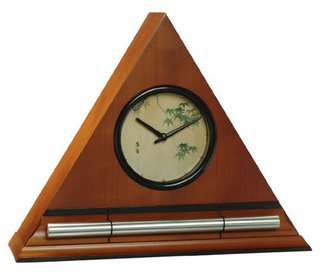 Chime Alarm Clock & Meditation Timers - Progressive Wake-Up Clock with Natural Acoustic Chime Now & Zen’s Clock & Timer Shop
1638 Pearl Sreet
Boulder, CO 80302
(800) 779-6383
Posted in Bamboo Chime Clocks, intention, Meditation Timers, Meditation Tools, mindfulness practice, Well-being, yoga, Zen Timers
 Inner Peace
by Shyalpa Tenzin Rinpoche
It is a misunderstanding to think that the practice of meditation is merely a method for relieving stress and achieving peace for oneself, alone.
In Buddhist tradition, the act of practicing meditation should be approached as a means to benefit others. In the same way, the momentum that grows out of this practice should also be dedicated to the welfare of all beings. Each time you sit down to meditate, make your practice an offering for all beings. Recognize that everyone is looking for ways to find happiness just as you are. Meditation is a means to this end. Sustained meditation practice will bring you joy, and a joyful mind will naturally benefit others. Resolve to meditate with this unselfish attitude.
When we begin meditation, we should first learn how to focus. Some discipline is required in order to be attentive in the moment and experience it fully. Most of the time, we are unable to focus our attention and are easily distracted. Our minds wander, and we are easily mesmerized by our perceptions and thoughts. We have a difficult time remaining focused.
 inner balance There are many ways to practice meditation. Let’s explore one approach: Sit up straight. When you begin, breathe naturally. Slowly settle into your breathing by counting the in and out movement of your breath 21 times. Touch the tip of your tongue lightly to the roof of your mouth. If you become drowsy, your tongue will drop down and rouse you from your slumber. Raise your tongue to the roof of your mouth again and concentrate.
If possible, sit with your legs crossed, keep your eyes open, and look straight ahead, beyond the tip of your nose. I would advise you not to close your eyes. If you were to suddenly encounter a tiger in the jungle and were overcome with fear, closing your eyes would not make the tiger run away. Similarly, when you meditate, closing your eyes will not make your distracting thoughts and feelings disappear. You will be alert and prepared to face any challenge when you keep your eyes open. You may think you can meditate more effectively with your eyes closed, but most likely, you are not meditating better, you are sleeping better.
Once you have adjusted your body and settled into your breathing, focus on a specific object, such as the form of the Buddha. This could be an actual statue or an image visualized in the mind’s eye. You could select one aspect, such as the Buddha’s gentle eyes or his golden color. When you notice that your mind has wandered away from its focal point, gently bring it back. If you find yourself thinking about your stock portfolio or that you forgot to turn on the dishwasher, return your attention to the Buddha’s image. The value of your stock portfolio is a mundane matter and your dirty dishes can wait. The mind is running around like a restless monkey all the time. Obviously, this practice can be quite challenging. Observe how long you can hold the object of your attention without wandering. If you can hold your attention steady for five minutes, you are a great meditator already! Most likely, you will lose your focus, jumping from one thought to the next, like a monkey leaping from tree to tree. Staying with the object without drifting away is very difficult; it will take all of your attention and resolve. Throughout your day, you can practice this meditation technique whenever you have some free time.
 Buddha Practice meditation for whatever length of time you wish. However, in the beginning, practice for short periods, perhaps just five minutes. After meditating for five minutes, you might feel that you are struggling with your mind. If so, relax and tell yourself, “You spoiled brat, go wherever you like!” Let your mind wander as far as Paris, New York, or Shanghai. You can move your body, stretch, dance, or go a little crazy. Once you feel refreshed, return to your meditation again for five more minutes. Proceed like this—concentrating and then relaxing—for perhaps half an hour to an hour. Practice for whatever length of time you find comfortable, without overexerting yourself. Maintaining unwavering attention for five minutes is much better than getting lost in distraction for five hours.
This basic practice of focusing attention is important, even for the most advanced practitioners. If you allow a glass full of muddy water to sit undisturbed, the dirt will settle to the bottom, leaving a glass of pure water. Practicing this simple technique of focusing and restoring your attention when your mind wanders will pacify your restless thoughts. It will calm your mind, and with sustained practice, you will experience lucidity and pure presence.
 meditation When you practice meditation, the trials and tribulations—the highs and lows—of your day-to-day life will not disturb you too much, since your body and mind will be more relaxed. There will be a more intimate connection between your meditation practice and whatever comes up in your life. Even if chaotic or fearsome events turn your world upside-down, you will have more space and less stress. If your life swerves off the road and crashes, the fruits of your practice will act like an airbag, buffering you against serious injury. You will have the strength and clarity to master challenging situations.
Practice by focusing and holding your attention. If you cannot discipline yourself in this way, you could easily find yourself behaving like a spoiled and pampered child who feels helpless when confronted with a challenging situation.
When you develop the capacity to be present, you will respond competently, no matter what the circumstances.
Endeavor to practice some form of meditation each day. Even if you are transacting million-dollar business deals, this will pale in comparison to the rewards of a regular meditation practice. You can live without a milliondollar deal, but you cannot live without inner peace and well-being. So be good to yourself. Make a profound deal with yourself to practice every day. Set aside a little time for meditation, and then gradually spend more and more time practicing. In this way, the truth of the teachings will unfold within the depths of your heart. If you allow these teachings to remain only in your head, you could carelessly misuse the rest of your precious human life. This is not a practice for beginners only. Everyone must master this discipline before they can proceed further in their practice.
After meditating, rejoice and dedicate the fruits of your practice to all beings. With joy, rest in a sublime state. Make this aspiration:
“Whatever benefit I have gained from this practice, may the residual effects last for many days, years, and lifetimes. May everyone, including myself, benefit from the wisdom and clarity accumulated in this practice, until all beings attain enlightenment. Whatever merit I have gained, I dedicate it for the welfare of all sentient beings.”
By making this dedication, you will preserve this positive energy, and your practice will grow stronger in the future.
 develop a mindfulness practice You can draw on this energy for the dual benefit of yourself and others. In the Buddhist tradition, there are three sublime practices:
The first sublime practice is the generation of a compassionate and loving heart, also known as pure intention. We begin each activity with the positive intention that our action will be of benefit to others.
The second sublime practice is the activity or practice itself, which we do mindfully, while remaining in the natural state, free from distraction.
The third sublime practice is the dedication of merit. Merit refers to the wholesome and positive momentum that grows from our practice. We dedicate our most precious essence and all the positive energy that we have accumulated from our practice to the welfare of all beings.
Apply these three sublime practices in all of your activities, even something as simple as drinking a cup of tea. Prepare your tea while generating a compassionate heart, the pure intention to benefit all sentient beings. This is the first practice. Then drink the cup of tea with complete mindfulness. This is the second practice and the core of the three practices. After your last sip, dedicate the enjoyment of your drink for all beings, and pray that they may be liberated from suffering and awaken to enlightenment.
The rays of the sun provide warmth for all creatures without discrimination. We dedicate the virtue of every positive action to the benefit of all beings. In this tradition, we do not hold on to the merit that we have accumulated for our own benefit alone, but instead we dedicate this positive energy so that someday the enlightened qualities of every being will manifest. Finally, the perfect dedication is to dissolve your merit in the unconditional state.
 finding inner balance In this way, simply drinking a cup of tea becomes genuine meditation because of the three sublime practices. Always insure that these practices are inseparable from whatever you do. The first and last are quite straightforward. In the case of the second sublime practice, you have a specific target. For instance, if your activity is meditation on the breath, follow your breath attentively, and at the same time be mindful of its ephemeral quality. The three sublime practices are the best way to elevate your thinking and walk with dignity on the path of awakening.
The goal of our practice is to free ourselves from stress and suffering. We cannot actualize this freedom using a purely intellectual approach. We need to experience these teachings directly and embody them in our lives. This is why I strongly recommend the practice of meditation.
As beginners, we must embrace the practice of meditation. Even if the discipline of meditation does not come easily, we should endeavor to practice. We have to tame our neuroses and pacify our restless minds.
Steady discipline, combined with joyful effort, is the best way to respect and care for yourself. As your practice progresses, you will begin to reap the rewards. You will carry yourself in a majestic way and experience the regal qualities of your wakeful nature. Like a king in command of his subjects, you will master your mind and emotions.
Every moment is a new moment, so we need a fresh approach to meditation that can be practiced by everyone, anywhere in the world. Our meditation will be pristine when we recollect, with an open heart, the basic goodness in all beings. There is no time to be narrowminded or territorial, as life is too precious to waste. We should not spoil a single moment with an unwholesome thought. This dynamic form of meditation can be practiced nonstop, so that living itself becomes meditation.
Moment-to-moment awareness is the supreme form of meditation. All other methods of meditation are steps that lead us toward this all-pervasive awareness. Recognizing the essence of one’s mind and learning to remain in this essence is true meditation. In Tibetan, meditation means “getting used to.” We could say that meditation is not the goal, but a tool that helps us discover or “get used to” the true nature of mind. Once you realize the truth, you no longer need the tool. When resting in the mind’s nature, there is nothing left to meditate on because the mind is no longer distracted! There is nothing more to grow accustomed to. Nonmeditation is the ultimate meditation. Whatever comes, you are capable of handling it because everything is self-liberated as it arises.
 sacred meditation altar If you must have a quiet and secluded place to meditate, your practice is still ordinary. However, with moment-to-moment awareness we can manage any situation. This is what we need the most because life is often chaotic and challenging. We have to survive and navigate the strains and stresses of everyday life. Buddhist practice is not simply a matter of reciting mantras, chanting prayers, and quietly meditating. True practice means learning to handle every situation skillfully.
Whatever you are doing, do it comfortably. Proceed in a relaxed and natural manner. You will experience thoughts arising one after the other. A thought comes and it goes. When you are alert and aware, you will not get lost in your thoughts. It will be clear that you are not your thoughts and that your thoughts do not define you. Thoughts are like the flight of a bird through the sky: the path of the bird leaves no trace. Each thought has no dwelling place or destination. When you train this way, the “possessor” of these thoughts will eventually disappear. At this point, there will be no one to suffer or experience any torment. This is moment-to-moment awareness and the perfection of nonmeditation.
Adapted from the book Living Fully: Finding Joy in Every Breath ©2012 by Shyalpa Tenzin Rinpoche. Printed with permission from New World Library.
Although meditation can be done in almost any context, practitioners usually employ a quiet, tranquil space, a meditation cushion or bench, and some kind of timing device to time the meditation session. Ideally, the more these accoutrements can be integrated the better. Thus, it is conducive to a satisfying meditation practice to have a timer or clock that is tranquil and beautiful. Using a kitchen timer or beeper watch is less than ideal. And it was with these considerations in mind that we designed our digital Zen Alarm Clock and practice timer. This unique “Zen Clock” features a long-resonating acoustic chime that brings the meditation session to a gradual close, preserving the environment of stillness while also acting as an effective time signal.
 relaxing chime alarm clocks by Now & Zen Now & Zen’s Meditation Timer Store
1638 Pearl St.
Boulder, CO 80302
(800) 779-6383
Posted in Meditation Timers, Meditation Tools, mindfulness practice
 breathing to calm down What You’ll Need
A timer or stopwatch; a folded blanket or firm cushion.
What It Does
This practice calms the mind and the central nervous system, helping put the brakes on a frenzied pace. “When you slow your breathing down, you slow your life down,” says Strom. Plus, it can spark your creativity. “I’ve had students stop in the middle of class and grab a pen. When the mind chatter stops, the ideas fly in.”
How to Do It
Set your Zen Timer with bowl for three minutes so you don’t have to keep track. Be sure to keep your spine erect. (Slouching can inhibit deep breathing.)
-Begin to lengthen the inhalation and exhalation (breathing slowly through your nose). First try inhaling for a count of four and exhaling for a count of four, then lengthen (aim for a count of seven on the in breath and seven on the out breath).
-Be careful not to hold your breath. You want to slow it down, not stop it.
-When the timer goes off, return to a normal breathing pace.
Use our unique “Zen Clock” which functions as a Yoga Timer. It features a long-resonating acoustic chime that brings your meditation or yoga session to a gradual close, preserving the environment of stillness while also acting as an effective time signal. Our Yoga Timer & Clock can be programmed to chime at the end of the meditation or yoga session or periodically throughout the session as a kind of sonic yantra. The beauty and functionality of the Zen Clock/Timer makes it a meditation tool that can actually help you “make time” for meditation in your life. Bring yourself back to balance.
adapted from Body + Soul, December 2006
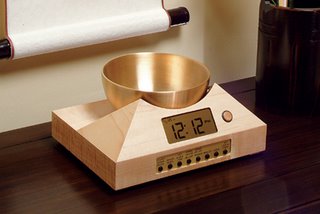 Zen Timer with Bowl Now & Zen – The Yoga Timer Store
1638 Pearl Street
Boulder, CO 80302
(800) 779-6383
Posted in Meditation Tools, mindfulness practice
 how to begin a meditation practice One effective stress-relief strategy is meditation: It’s free, it can be done almost anywhere at any time, and you don’t need any special equipment to practice. “Meditation teaches us focused concentration — and the more you do it, the easier it gets,” says Frank Lipman, M.D., holistic physician and creator of our Stress Relief Action Plan. The exercise below is adapted from Lipman’s book “Revive: Stop Feeling Spent and Start Living Again” (Fireside; 2009).
If taking up meditation seems daunting, however, start with devoting just 15 minutes a day to this beginner-friendly technique. Once you’ve made it a habit, deepen your practice with the additional technique below.
1. Set your Singing Bowl Gong Timer (Now & Zen, $199.95) for 15 minutes. Sit in a chair and allow your body to settle.
2. Slowly scan your body from toe to head, noticing where you feel tight.
3. Bring your attention to your breathing, inhaling and exhaling through the nose but never forcing your breath. Keep your mouth softly closed, your jaw relaxed.
4. Become more and more sensitive to your breath, in tune with where your body moves (and doesn’t move) on the inhale and exhale.
5. Allow your awareness of your breath to bring ease to your entire body. Imagine your body moving toward the earth, fully supported.
6. Continue observing your breath moving in and out of your body.
7. At the end of the 15 minutes when you hear the gentle chime from your Zen Timer, breathe deeply three times, allowing the inhale to move down to your toes and the exhale to move up and out of the tops of your shoulders. Pause and then open your eyes.
adapted from Body + Soul, January/February 2010
Our Zen Timepiece’s acoustic 6-inch brass bowl-gong clock is the world’s ultimate alarm clock, practice timer, and “mindfulness bell.” It has a beautiful Singing Bowl Gong that chimes.
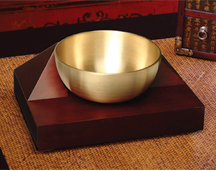 Singing Bowl Gong Meditation Timer and Alarm Clock
Now & Zen’s Singing Bowl Gong Timer Store
1638 Pearl Street
Boulder, CO 80302
(800) 779-6383
Posted in intention, Meditation Timers, Meditation Tools, mindfulness practice
 help with mind-body exercises
by Kristin Bjorsen
These three mind-body exercises—which you can do anywhere, anytime—calm the mind, alleviate PTSD symptoms (or any anxiety you may feel), and help you regain control of your life.
1. Soft-belly meditation: While sitting or lying down, breathe in through your nose and out your mouth. Allow your belly to be soft, letting it rise and fall gently. During the inhale, say the word soft to yourself, stretching it for the duration of the inhale. On the exhale, say, belly. Do this for seven minutes. You should see a drop in your blood pressure and heart rate.
2. Autogenic training: Lie comfortably, and do soft-belly breathing for a few minutes. Then slowly repeat the phrase “My arms are warm and heavy” six times. Now do the same with the following phrases: “My legs are warm and heavy”; “My heartbeat is calm and regular”; “My abdomen radiates warmth”; “My forehead is cool”; “My breathing is easy.” If you don’t have time to do all six phrases, do the first, second, and last one. This simple exercise will activate the calming, parasympathetic nervous system. Perform it in the morning and then during the day or at night if you’re feeling anxious or restless.
 easy mind-body exercises 3. Energy tapping: If a stressful emotion or disturbing thought strikes, allow yourself to experience it fully. On a scale of 0 to 10, decide how bad it is. Then with a fingertip, tap on each of these points for a few seconds: the center of the forehead (the “third-eye” point), underneath the nose, the center of the chin, or the center of the sternum. Check in again on the problem. If it still registers on the scale, tap on the points that helped the most for several seconds. Repeat until the emotion or thought no longer registers and you feel calm and serene.
 Wake up with Acoustic Chimes Now & Zen
1638 Pearl St.
Boulder, CO 80302
(800) 779-6383
Posted in Meditation Timers, Meditation Tools, mindfulness practice
 Flowering Plum and Moon, Koson Inspire your afternoon or evenings and refresh your senses by creating sacred space for a personal tea ceremony.
From the fragrant aromas to the delicate flavors to the simple comfort of a warm mug, tea is a meditation for the senses. It also creates space to unwind and reconnect.
Preparing it is a process, one that forces you to slow down and relax. “Tea is a gift from the earth,” says Diana Rosen, author of “Meditations With Tea,” “and enjoying it is a gift to yourself.”
By creating your own daily tea ritual in the afternoon when the day tends to drag, you can refresh your senses, refocus your thoughts, enjoy some peace, and — the best part — introduce a sacred moment into your day.
Prepare for Tea
In one traditional Japanese tea ceremony, guests are met at the gate by their host and led silently through a garden to the tea room, signifying a departure from the everyday world and an entrance into a spiritual realm.
You probably don’t have a dedicated tea room, but you too can create a space in your afternoon for disconnecting from the day’s stresses, whether you’re at the office or at home. Here’s our simple step-by-step approach to creating your own personal tea ceremony.
Dedicate a Space
This can mean moving to another room, a favorite chair, or just to the other side of your desk — or simply clearing a space for tea on your table or work space. You might consider using a place mat or a tray to visually set your tea space apart from everything else.
 Teapot and cup with green tea Set the Stage
A tea ceremony is about atmosphere. Light a candle or play music to set the mood. If you’re in a busy office, just close your eyes and listen to your breath for a few minutes to switch gears and set the tone. Set your Zen Alarm Clock so that you will hear a lovely chime at the end of your tea time.
Select Your Tea
Bring some intention to your choice. What are you in the mood for? A mild, grassy green? A refreshing peppermint? A rich, vibrant oolong or black tea? As Confucius said, “Let your palate be your guide.”
Use Your Favorite Accoutrements
The personal objects you use for tea making will help make this practice your own. Whether it’s a pretty mug, an iron teapot, or a favorite infuser, using something special for your tea ritual inspires a ceremonial feel. Set your Zen Alarm Clock & Timer to time your tea for 5 minutes for optimal taste.
exerpted from Body + Soul, September 2005
 Digital Zen Timer, good for timing tea Now & Zen’s Chime
Timer Store
1638 Pearl Street
Boulder, CO 80302
(800) 779-6383
Posted in Chime Alarm Clocks, Japanese Inspired Zen Clocks, mindfulness practice, Now & Zen Alarm Clocks
 Mindfulness Practice - Meditation I sat cross-legged on the living-room rug, closed my eyes, took a deep breath, and tried to quiet my mind. Alas, random thoughts persisted, flickering about like fireflies on a summer evening. After five minutes, I abandoned my Zen pose. I would have rather folded laundry or gone on a 3-mile run—anything with more tangible results.
One day, I shared my frustrations about meditating correctly with a practiced teacher and learned that there was no wrong way to meditate—it would be like breathing wrong. I was trying too hard. She suggested I come to her meditation group, but meditating with a dozen other people sounded distracting, and sitting in a library chair wasn’t exactly my definition of bliss. But I liked her “can’t do it wrong” approach, so I ventured to the library basement for this “meditation spa.”
The first thing I noticed was the particularity of the circular chair positioning. As a writer, I appreciated such attention to flow. A more sporadic placement, like an awkward transition or misplaced passage, would have detracted from the whole. Mood music, dimmed lights, and quiet conversation helped me relax. Sensing we were ready, our instructor asked us to close our eyes and inhale deeply. On the exhale, we joined her in chanting om, releasing our breath for as long as possible. We did this three times, our voices overlapping in one long melodious note, as tranquil as a wind chime. The chanting slowed my breathing and stilled my mind for a short time, and when thoughts popped up, I did my best to ignore them. Then the instructor asked us to drink in a white light, each breath filling us up like a balloon. After about 20 minutes, she gently “brought us back,” though there was no place to come back from with the sound of a Zen Meditation Timer. We’d never left the library basement.
What I discovered was that meditating perfectly is not only unattainable—it’s missing the point. It’s not the mantra, the breathing, the teacher, or the time of day; instead, it is the simplicity of peace and silence I found within myself through meditating. Now when I meditate, I don’t get upset when I worry or when I can’t empty my mind. Instead, I try to open myself a little more each time to the stillness that has always been there.
adapted from Natural Solutions Magazine, July 2008 by Susan Lembo Balik
The Walnut Digital Zen Clock’s long-resonating Tibetan bell-like chime makes waking up and meditating a beautiful experience! When the clock’s alarm is triggered, the acoustic chime bar is struck just once … 3-1/2 minutes later it strikes again … chime strikes become more frequent over 10 minutes … eventually striking every 5 seconds until shut off.
Our Meditation Chime Timer also serves as a countdown and interval timer for yoga, meditation, bodywork, etc.; and it can also be set to chime on the hour as a tool for “mindfulness.”
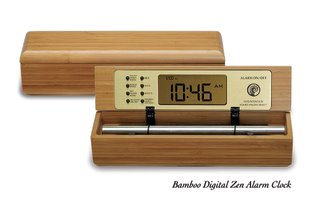 Zen Meditation Timer in Bamboo with Natural Acoustic Chime Now & Zen’s Meditation Chime Timer Shop
1638 Pearl Street
Boulder, CO 80302
(800) 779-6383
Posted in intention, Meditation Timers, Meditation Tools, mindfulness practice, Zen Timers
 winter self massage During winter, nature sighs deeply and burrows down for a long sleep. Like the denning bears and squirrels, use these cozy times to reduce stress. Especially in urban environments, we often become detached from this seasonal message. Continuing at a frenzied pace, we develop anxiety, high blood pressure, and digestive upset. To reduce stress, “in winter we focus a lot more on massage and nutrition,” says hydrotherapist Kristi Zimmer. Try this self-massage five minutes before bed and just after waking up in the morning: Set your Zen Chime Timer for 5 minutes. Lie on your back and make gentle circular motions around your belly with both hands, going clockwise as you breathe deeply. After five minutes of this, leave your hands on your stomach as you take 20 deep breaths, sending the breath to your organs. The deep breathing calms the body and mind, while the massage aids digestion.
adapted from Natural Solutions Magazine, January 2007 by Nora Isaacs
 Chime Timers in Bamboo with Natural Acoustic Chimes Now & Zen’s Natural Chime Timer Store
1638 Pearl Street
Boulder, CO 80302
(800) 779-6383
Posted in Bamboo Chime Clocks, Chime Alarm Clocks, intention, Meditation Timers, Meditation Tools, mindfulness practice, Natural Awakening, Well-being, Zen Timers
 Use Mindfulness Practices to Stop Stress You’re cut off while driving. Your children erupt into a screaming fight. Or you’re five minutes away from an interview for the job of your dreams and your composure evaporates in a rush of anxiety. When life delivers adversity, stress is the common response. Your body kicks into action, preparing for a fight. The adrenal glands pump out adrenaline and noradrenaline — hormones that increase the heart rate, quicken breathing, raise blood pressure, and tense muscles. You’re ready to take on the perceived threat to your safety or well-being.
Of course, in reality we rarely run from foes or physically challenge them. As a result, we don’t burn off these powerful hormones, leaving them to “course through our bloodstream,” explains Dr. Herbert Benson, a pioneer in stress research at Harvard Medical School’s Mind/Body Medical Institute. In the short term, a pounding heart and sweaty palms can exacerbate the stressful emotions you’re already feeling. Left unchecked, this chemical mix sets you up for an array of physical and emotional problems, says Benson, including anxiety, depression, and intensified PMS and menopause symptoms.
The next time you are facing a stressful situation, stop yourself from spiraling out of control and bring yourself back to center.
Our Zen Timepiece’s acoustic 6-inch brass bowl-gong clock & timer is the world’s ultimate alarm clock, practice timer, and “mindfulness bell.”
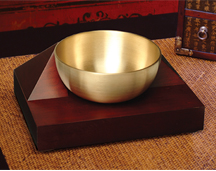 Acoustic Chime Timer and Alarm Clocks from Now & Zen - Boulder, CO
It fills your environment with beautifully complex tones whenever it strikes. In the morning, its exquisite sounds summon your consciousness into awakening with a series of subtle gongs that provide an elegant beginning to your day. Once you experience the Zen Timepiece’s progressive awakening, you’ll never want to wake up any other way. It also serves as the perfect meditation timer and ‘mindfulness practice clock’.
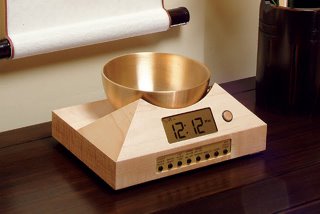 Mindfulness Practice Timer with Singing Bowl Adapted from Body + Soul, text by Erin O’Donnell
Now & Zen Meditation Timer Store
1638 Pearl Street
Boulder, CO 80302
(800) 779-6383
Posted in Bamboo Chime Clocks, Chime Alarm Clocks, intention, Japanese Inspired Zen Clocks, Meditation Tools, mindfulness practice, Now & Zen Alarm Clocks, Truth, Well-being
 Music as a mindfulness practice
By Joseph Cardillo, PHD, and Galina Mindlin, MD, PhD
Daily life is often about juggling a variety of issues and trying to stay on top of it all. It is, however, easy to slip out of your mental best into something less productive.
Stressors are a major contributor to losing our mental edge throughout the day. Some are expected, like obligations, deadlines, and new projects. But there are the unforeseen ones too, like computer crashes, slow information processing, and interpersonal issues. Other factors that lower optimum performance range from emotional to organizational issues.
Many individuals resort to products like caffeine and energy drinks for that quick energy boost. In small amounts, these products can certainly do the trick, though not without side-effects, and the results are short term. You may ask, isn’t there something else? The answer may be as simple as reaching for your iPod, MP3 player, or cell phone.
We all know how good it feels to hear our favorite song. Imagine powering up your brain with that clean, positive energy at will, anytime, anywhere, and without side-effects. Imagine being able to think more clearly than usual, with a heightened perception of your surroundings, and being able to reach that state whenever or wherever feel the you need.
Neurological imaging has shown that music has a profound effect on both your mind and body. Whether your musical taste is Bono, Billie Holiday, or Celine Dion, you can customize playlists (a combination of your favorite songs) to keep you emotionally sharp and balanced, offering a natural way to relieve anxiety; increase alertness; feel happier; sharpen memory; improve mood; and fight off insomnia, depression, and even addictions without any side effects!
Psychologically, music can be used to change the way you operate in specific situations (like that next office meeting, family outing, or trip to the doctor). It can increase your ability to deal with stress and call forth your peak mindset in everything you do.
But what exactly is your peak mindset? Scientifically, it is a “balanced” mindset, meaning you are simultaneously operating from a place of both maximum calm and maximum alert. So you are not stressed at all—quite the opposite really—and you are highly alert, flowing from one thought, decision, or action to another. Your focus is peaked.
Optimum Calm and Alertness
Optimum calm is not your deepest calm; it is reaching the point where, if you got any calmer, you’d be too mellow. Even one drop more calmness would be too much. The same goes for your alertness: You’re optimally alert when any more excitement is too much and would leave you feeling “wired.” You’re at your “best” when you are balanced.
This is where music comes in. You can customize your iPod, MP3 player, or cell phone into a device to optimize your mindset in seconds. Here’s how:
1. Pay Attention to How You Are Feeling:
Figure out what you feel like when your mind is not in balance—you may feel out of sorts, too jumpy, or too mellow to get a certain task done.
2. Put Together a Playlist that Can Move Your Mindset Up or Down (Alert or Calm):
Start using your playlist (or any song on repeat mode) to help you into your mental best prior to specific situations and then again after seven to 10 minutes. The goal is to use your favorite music to reset your brain to its optimum performance. Note: Staying in a less optimum mindset long enough will make that your “normal” operating mindset. Here is how to begin a playlist that can balance you:
• First, pick calming songs you like a lot.
Choose any kind of music that calms your anxiety. Experiment. You can develop real precision in picking the right songs to relax you in specific situations. Sometimes, you instantly recognize what music you need at just that moment to soothe you. Select from those songs first. But then try listening to a variety of other songs you believe can more exactly relate to your specific needs at certain moments. For example, are you on your way to meet with new employees or are you headed to a meeting? Are you angry, sad, or anxious? Are there songs that instill calm into you, given where you are, how you’re feeling, and your goal? Begin tracking how specific songs change your moods and leave you feeling in specific situations. Add these to your playlist. Title situation-specific playlists for breaking down anxiety or creating calm, such as: “Before a Public Speaking Engagement,” “Going Home from Work,” “Traffic Jams,” or “Before Office Meetings.”
• Look for alertness-energizing songs.
Counter-balance calm songs with energizing, upbeat songs. This can help give you a boost when you need it.
• Pay attention to when a certain song works and when it doesn’t.
Songs are not always situationally interchangeable.
 music and mindfulness • Ingrain songs into your memory by playing them a lot.
So when you can’t listen to your calming or energizing songs, you have them stored in your mind.
• Make task-oriented playlists. Train your brain with your assembled playlist before and after specific tasks. This sends your brain the message that you want this specific mindset in all similar situations. Soon you will be able to call up your optimum mindset whenever you need it, whether you are actually playing the songs or not.
3. Spike Your Songs’ Effects:
Make a mental movie as your song plays. Maybe it is a song from long ago that made you feel safe and peaceful. Tip: Songs from your childhood, ones your mother may have played when you were a child that remind you of pleasant memories, or ones you may have sung with friends or to your own children, are great for relaxing. One business professional I know “charged up” with a song he and his friends would listen to on their way to high school soccer games when everybody got into an excited team mentality. Thinking about images or scenes as you listen to alerting or calming tunes will put your mind into “remembering mode.” This mode will transfer and give you faster recall with upcoming tasks—say, a meeting or presentation. What will work for you will be your own favorite songs.
The most important thing is getting your playlists set up in advance. This way you can carry your best mindset with you right in your pocket and have it at the push of a button. Then all you have to do is train your brain by using your lists over and over. You should begin to see effects in about three weeks. Enjoy the process!
Joseph Cardillo, PhD, is the best-selling author of Be Like Water and other books. He has taught at various universities, including the University of Albany. He received the prestigious 2011 State University of New York Chancellor’s Award for Scholarly Research.
Galina Mindlin, MD, PhD, is an assistant professor of psychiatry at Columbia University, the founder of Brain Music Therapy (BMT) in the United States, and the clinical and executive director of the BMT Center New York City.
The Walnut Digital Zen Clock’s long-resonating Tibetan bell-like chime makes waking and meditating a beautiful experience – its progressive chimes begin your day with grace. When the clock’s alarm is triggered, the acoustic chime bar is struck just once … 3-1/2 minutes later it strikes again … chime strikes become more frequent over 10 minutes … eventually striking every 5 seconds until shut off.
 Walnut Digital Chime Timer & Alarm Clock - Boulder, CO The Digital Zen Chime Timer & Clock serves as a countdown and interval timer for yoga, meditation, bodywork, etc.; and it can also be set to chime on the hour as a tool for “mindfulness.”
 Digital Acoustic Chime Alarm Clocks from Now & Zen Now & Zen’s Chime Meditation Timer Shop
1638 Pearl St.
Boulder, CO 80302
(800) 779-6383
Posted in mindfulness practice
« Previous Page — « Previous Entries
Next Entries » — Next Page »
|
|
|
|